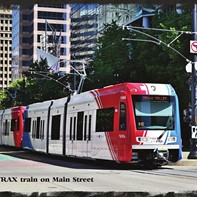Money Train
Critics complain that UTA cronies keep taking taxpayers for a ride
By Katharine Biele @kathybielePage 2 of 3
Fiscally Insane
There is a compelling dichotomy between the desire for good transit and the reality of it. The Cato Institute, a conservative think tank, has long researched the issue.
“The agencies that spend taxpayer dollars building these lines almost invariably call them successful even when they go an average of 40 percent over budget and, in many cases, carry an insignificant number of riders,” the institute’s Randal O’Toole wrote in his 2010 paper. “The people who rarely or never ride these lines but will have to pay for them should ask, ‘How do you define success?’ ”
Good question for UTA, whose total debt increased to $1.8 billion, according to the 2012 legislative audit. Salt Lake City began its rail experiment in 1999, but by 2005, still only had a 1.2 percent share of motorized passenger traffic, according to the Federal Transit Administration.
In 2009, Salt Lake was tied for sixth among the 10 best cities for public transportation, ranked by U.S. News & World Report, but that was based on ridership, safety and government spending. “For the cost they’re putting into this, we could probably hire limousines to move people,” Geddes says.
O’Toole has studied the Utah phenomenon as well. In 2011—the last year for which federal data was available—UTA spent $208 million on operating its system. A quarter of that came from the federal government. It spent $445 million on capital improvements—in other words, for every dollar of operating costs, UTA spent $2 on construction.
“UTA has been in a phase of expansion, and our enabling statute provides for that to be financed though bonding, not unlike other governmental entities,” UTA spokesman Remi Barron says. “Bonds were issued to build new rail lines and add bus service to outlying areas. While we do carry debt, the service on our bonds is just 20 percent of our annual revenues for 2013, not unlike a mortgage for a typical household. With the opening of the Draper line this summer, our 2015 construction plan will be completed two years ahead of schedule and $300 million under budget. Our debt is not out of line given UTA’s rapid expansion.”
An example of UTA’s spending priorities can be seen in the construction of two $25 million parking garages at the West Jordan TRAX station—both of which stand empty, awaiting 2030, when they are projected to be needed. They were built now to qualify for federal funding. And they are empty because some planned apartments, scheduled to start construction this fall, fell victim to a bad economy.
UTA’s now-retired chief executive officer, John Inglish, earned $348,929 a year between his salary and bonuses. As of May 2012, General Manager Michael Allegra was making a total compensation package of $319,360, according to UtahsRight.com. UTA says the salaries, compared with other transit agencies, are justified. And Barron says that Allegra, in 2012, made $74,000 less than Inglish, which would be $274,929.
Meanwhile, UTA’s fares are among the highest in the nation, according to a 2012 survey by the American Public Transportation Association.
While UTA is expanding its infrastructure, it’s shrinking operations. The system has already experienced cuts in bus service. Portland, Ore., often seen as a model for Utah’s future, is suffering the consequences of this kind of planning.
Tri-County Metropolitan Transportation District of Oregon built its first line in 1986. TriMet instituted cuts in transit service in 2012 while still building more trains. The regional transit agency—which, like UTA, runs buses, commuter rail and light rail—has had more than $43 million in service cuts since 2009, plus fare hikes, the elimination of the Free Rail Zone, longer commute times and overcrowded buses and trains, according to the TriMet website. And the worst might be yet to come—70 percent cuts by 2025, with the loss of 63 bus lines.
“Salt Lake City has built all these light-rail and commuter trains, and it’s just fiscally insane,” O’Toole says in an interview. “It’s taking a huge obligation from taxpayers for maintaining it in the future … and they’re cannibalizing bus service to operate it.”
In San Francisco, Bay Area Rapid Transit (BART) ridership is stagnant; Atlanta has seen its population triple and its per-capita ridership decline by two-thirds, O’Toole says.
“It was so bad in Los Angeles that the NAACP sued the L.A. transit authority for cutting service to low-income neighborhoods,” O’Toole says. The courts required restoration of service for 10 years.
In fact, it is minorities and the poor who suffer with light rail, which focuses on getting people out of their cars. “New riders are not bus riders,” O’Toole says.
Low-income advocates Crossroads Urban Center conducted a May survey of 272 food-pantry clients and found that 58.6 percent of them had not used public transit in the past month because of price. But 42 percent rode transit at least four times a week, compared to 5.8 percent of Salt Lake City residents in general. “When you look at who rides public transit, UTA is pursuing a mythical set of other riders,” says Bill Tibbitts, Crossroads associate director.
“Ridership data suggest that light rail pirated many passengers away from buses; rail carried 6.1 million riders in its first full year of operation, while buses carried 6.3 million fewer riders that year than in the year before light rail opened,” O’Toole wrote in his 2010 paper for the Cato Institute.
And, O’Toole concludes, while overestimating rail ridership by 20 percent, UTA was also “cooking the books” so that adding rail operations would make economic sense. “A federal oversight body has questioned the accuracy of UTA’s passenger counts,” the 2008 audit concluded. And it said staff has “knowingly reported incorrect data to the National Transit Database.” There has been no public follow-up.
Forced Urban Living
This brings us back to TODs. The idea is twofold—to provide development and therefore economic benefit from residential and retail establishments, and to concentrate commuter population around the development. “The goal of a TOD program is to hope [residents and commuters] use mass transit,” says Christina Oliver, UTA’s former TOD manager who has since moved to Salt Lake County government. “We’re not against vehicles, but we’re hoping that discretionary trips are people who go to work and don’t have a lot of meetings in between.”
O’Toole calls this something like forced urban living. It’s a myth of urban planning, he says, that as baby boomers retire, they will move into higher-density housing. “Urban planners long believed that more people want to live in multifamily housing than people who want to live in single-family homes. But people don’t move to Utah to live in higher densities. How do we force more Americans to live in places they don’t want to live?”
The answer, he says, is to build TODs. O’Toole disses University of Utah professor Arthur Nelson, who, in a recent Chicago Tribune article, asserts that people in their late 60s will begin selling off their homes and start renting. He calls it the Great Senior Sell-Off and believes that the demand for high-end rentals will surge. O’Toole maintains there’s not good research behind this assertion, but developers and real-estate executives have certainly bought into the idea, creating a kind of urban-planning debate.
It has been playing out in Clearfield, where the city has been hashing out plans for a TOD since 2009. Clearfield has gone through three developers, the latest being Thackeray Co. “One of the proposals had 3,000 multifamily units on that 70-acre site, and subsequently that proposal didn’t move forward,” says Clearfield Mayor Don Wood.
Wood said he understands that TODs are historically sites of a large number of multifamily units, but his community had concerns about that kind of density. They’ve compromised with UTA to add commercial and light industrial developments to the site.
All that’s left now is for the developer to pursue tax-increment financing, which would exempt the development from taxes for a number of years.
“Tax-increment financing (TIF) takes property taxes that would otherwise go to schools, fire, police and other essential services and spends it subsidizing development,” O’Toole wrote in a 2007 analysis of Portland, Ore. And while Portland spent hundreds of millions of dollars to subsidize development along the streetcar line and near light-rail stations, the development would have happened with or without rail, he says. But without subsidized development, nothing happened. “The subsidies, not the rail, are what attracts development,” O’Toole says.
More by Katharine Biele
-
Deseret News poll shows Donald Trump skating to another victory in Utah.
Hits & Misses
- Apr 17, 2024
-
LDS General Conference dominates local news while stories on diversity and discrimination take a back seat
Hits & Misses
- Apr 10, 2024
-
Utah's GOP Senate candidates try to out-MAGA each other in a race to the bottom.
Hits & Misses
- Apr 3, 2024
- More »
Latest in Cover Story
Readers also liked…
-
Forget the family pedigree—Robert F. Kennedy Jr should not be the next president of the United States
Trojan Horse
- Jun 21, 2023
-
Women decry harassment and toxic culture at St. George auto dealership
Men at Work
- Oct 11, 2023





